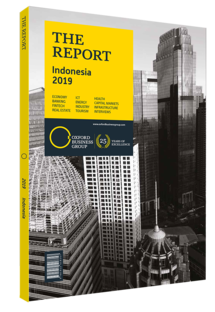Indonesia's growing middle class boosts consumer spending
Despite the rupiah sinking to its lowest level in over two decades, consumer spending in Indonesia expanded. Retail sales grew by 3.7% in 2018 from 2.9% in 2017. Household consumption rose 5.5% in 2018, up from 4.9% the year before. Clothing sales were particularly robust, jumping 15.1% compared to 1% in 2017. Automotive sales also increased significantly, from 1.7% in 2017 to 11.3%. This trend of retail growth is expected to continue, with a projected growth rate of 4.5% in 2019. The growing middle class is driving much of the increased consumer demand. “The middle class is growing tremendously, and the lifestyle habits of many consumers, especially those who are Jakarta-based, are really starting to change,” Eddyanto Hadisurjo, managing director of optical retailer Optik Melawai, told OBG. “Younger generations are really starting to become more brand-conscious, causing lesser, unknown brands to disappear from the market.”
Growing Middle
The middle class remains small when measured by spending power but is large in numbers. According to World Bank estimates, there are 52m in the Indonesian middle class – which represents about 20% of the population – accounting for 43% of total household consumption. Another 45% of Indonesians are considered no longer vulnerable to poverty. Household consumption currently accounts for 55% of GDP, the second-highest rate in ASEAN after the Philippines. In 2018 consumer spending was boosted by the hosting of two major events: the Asian Games in Jakarta and Palembang, and the 2018 Annual Meetings of the IMF and the World Bank in Bali. The country’s elections, scheduled for April 17, 2019, may also have played a role in this trend, as election-year budgets tend to feature increased government spending on popular policies and consumer benefits. The government also increased social spending, boosting the budget of allocations to low-income families from Rp19trn ($1.3bn) to Rp28trn ($2bn). The programme dispenses between Rp550,000 ($39) and Rp4m ($283.63) to families depending on factors such as the education level of their children, with participating families receiving on average Rp1.9m ($134.73) a year. The 7.7% pace of growth in retail sales in December 2018 was more than double the 3.4% recorded in the same period in 2017. This is likely to have been particularly beneficial for local retailers, who are comparatively more affordable and enjoy brand recognition. “Local retailers who have a strong and creative social media presence will see stable profits, especially because there is now a growing, tech-savvy middle class,” Stefanus Lo, president director of jewellery retailer Central Mega Kencana, told OBG. “Promotional events, especially outside of Jakarta, have also been quite beneficial for retailers to catch the eye of consumers in second- and third-tier cities.”
According to Roy Morgan Indonesia, a market research firm, long-term consumer confidence figures are strong. As of February 2019, 92% of Indonesians had positive expectations for the economy over the next five years. Meanwhile, some 80% of Indonesian executives surveyed in OBG’s Business Barometer in November 2018 reported having positive or very positive expectations for local business conditions, up from 76% in the previous survey, which was published in January 2018.
Increased Sophistication
Moving forward, investors in the retail sector can expect to expand distribution channels but must seek the right balance, Hadisurjo told OBG. Two of Indonesia’s unicorns – start-ups that have a market valuation of at least $1bn – are online marketplaces, Tokopedia and Bukalapak. However, this does not necessarily suggest that the future is bleak for bricks-and-mortar shops. “Product placement will be very important for retailers to consider, especially as the pace of technological change accelerates,” Hadisurjo added.
You have reached the limit of premium articles you can view for free.
Choose from the options below to purchase print or digital editions of our Reports. You can also purchase a website subscription giving you unlimited access to all of our Reports online for 12 months.
If you have already purchased this Report or have a website subscription, please login to continue.

